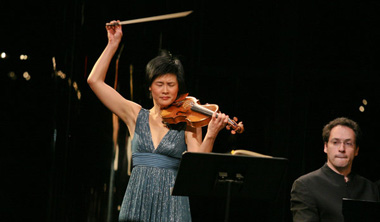The New York Times
By Vivien Schweitzer
August 25, 2011
original
link
Interpreting the Contrasts of Mozart
The pianist Artur Schnabel once described Mozart’s sonatas as too easy for children but too difficult for adults, referring to the relative ease of simply mastering the notes and the challenge of playing them well.

Ari Mintz for The New York Times
Mozart is perhaps the composer most likely to reveal flaws in ensemble work. But there were no cracks in the impressive partnership between the violinist Jennifer Koh and the pianist Shai Wosner on Wednesday evening, when they performed at the Kaplan Penthouse at Lincoln Center as part of A Little Night Music, the atmospheric series in the Mostly Mozart Festival.
The duo offered committed performances of three Mozart sonatas, with Mr. Wosner’s singing tone and expressive musicality complementing Ms. Koh’s insightful, richly hued playing.
The program included two of Mozart’s lesser-known works for violin and piano, beginning with the Sonata in E flat (K. 481). There was an appealing intimacy to their interpretation, notable in both the nuanced dialogue of the spirited Allegro molto and the ensuing Adagio.
Unusually, the Sonata in C (K. 303), which came next, has only two movements. Ms. Koh and Mr. Wosner illuminated the dramatic contrasts of the first section, which begins with an introspective Adagio and quickly morphs into a sparkling Allegro.
The concert concluded with the Sonata in B flat (K. 454), the best-known work on the program and one that Ms. Koh aptly described as one of Mozart’s “most operatic sonatas.”
Mozart didn’t have time to write out the piano part before he gave the premiere with the young Italian violinist Regina Strinasacchi at a 1784 concert attended by Emperor Joseph II. It is said that the emperor, seeing a blank sheet of music on the piano, teased Mozart by asking to see the manuscript.
The work’s operatic character is evident in the dramatic chords that begin the opening Largo and in the dialogue that unfolds afterward, with both instruments equal partners throughout the sonata. The duo’s soulful, richly wrought rendition of the Andante was particularly admirable.
A version of this review appeared in print on August 26, 2011, on page C2 of the New York edition with the headline: Interpreting The Contrasts Of Mozart.
Copyright ©2011 The New York Times
© Jennifer Koh, All Rights Reserved. Photography by Juergen Frank. Site by ycArt design studio